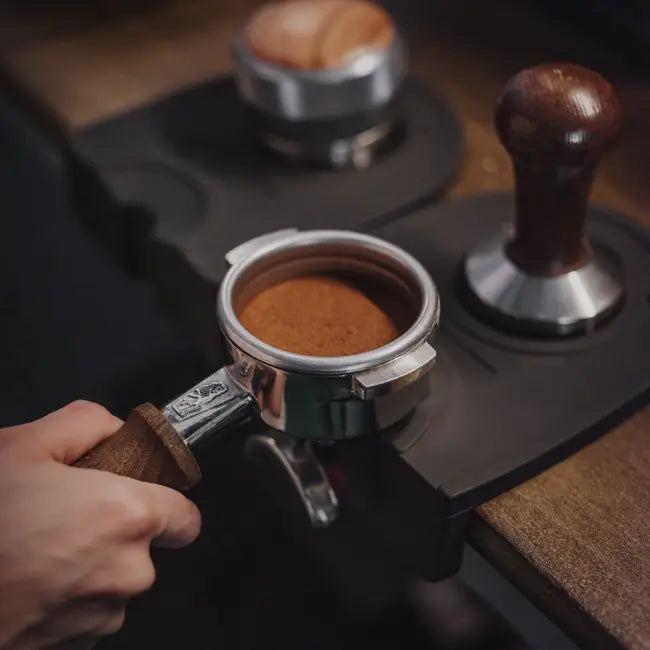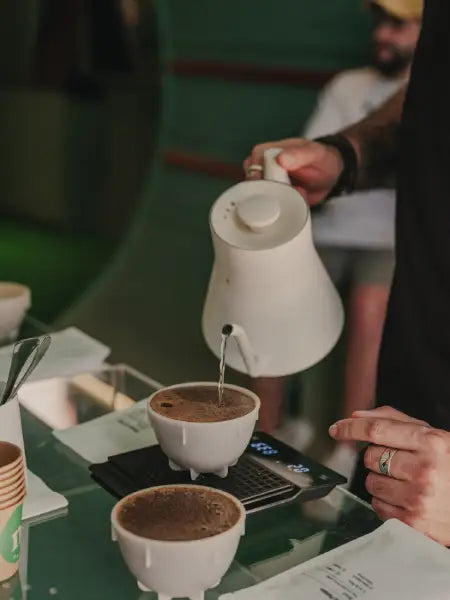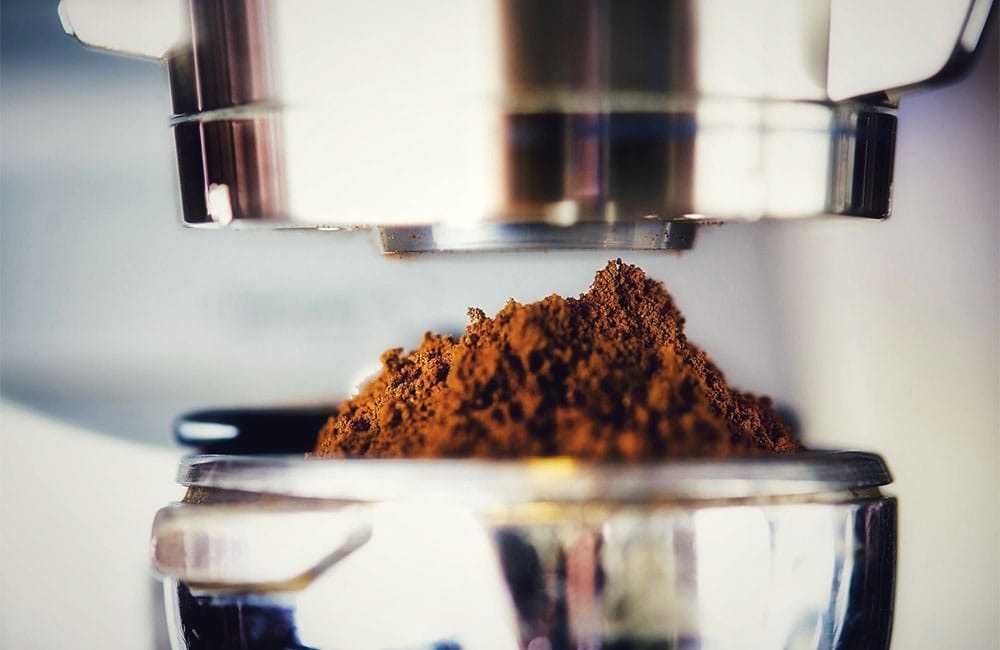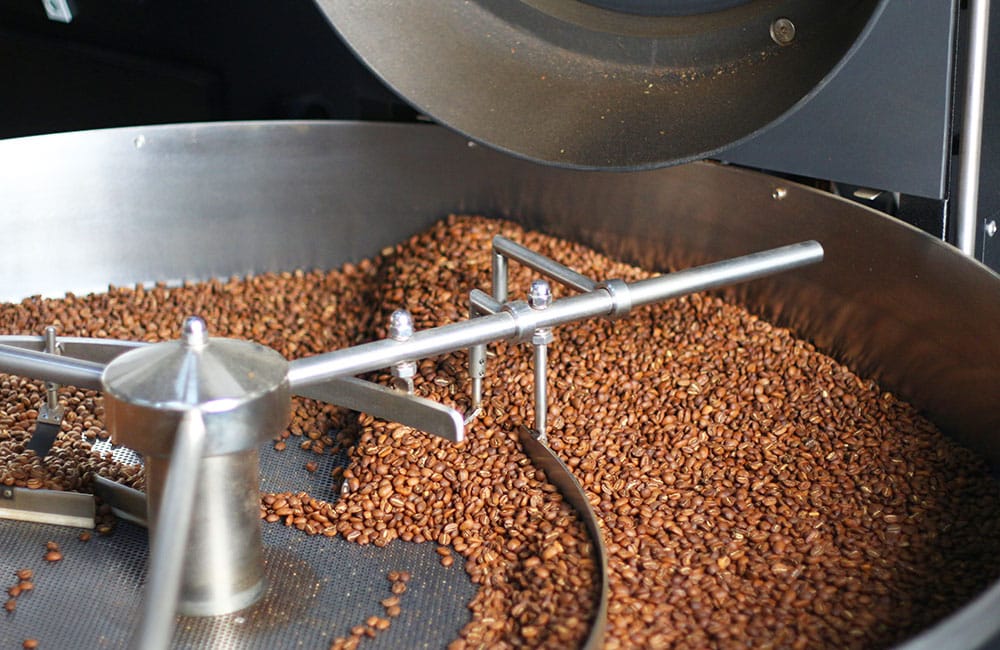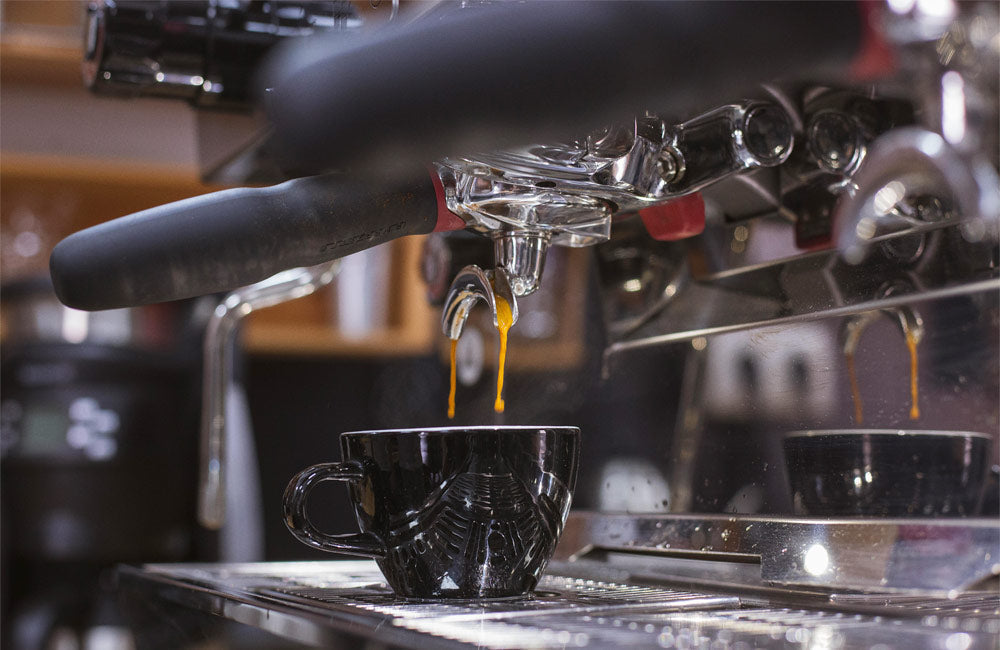Café molido
Marco Polo es uno de los viajeros y comerciantes más conocidos, a pesar de que sus viajes tuvieron lugar en siglo XIII. Durante sus muchos viajes, que le llevaron a recorrer Asia, especialmente la actual Mongolia y China, Marco Polo siempre comerciaba.
Viajó por la Ruta de la seda y uno de los bienes más preciados que se movían por esta ruta eran las especias: pimienta de la India, canela de Ceilán o jengibre de China. Las especias y el café comparten una historia común, la de este comercio intercontinental.
Pero también algo más, si los mueles antes de usarlos, pierden propiedades. Por eso el café molido no era apto para transportarlo de un lugar a otro entonces, pero es que tampoco lo es ahora. Y de eso va este post: por qué es mejor mantener el café en grano hasta que lo vayamos a usar y cómo molerlo
¿De qué hablamos cuando hablamos de café molido?

Brote de una planta de café
Puede parecer una pregunta redundante, pero no lo es. El café es la semilla de la baya de la planta de los cafetos.
Es decir, es una semilla en forma de grano como muchas otras. Pero al molerlo y realizar la extracción con agua obtenemos una bebida que tiene unas cualidades organolépticas y unas propiedades muy particulares.
Todos los estadios del proceso del café son importantes.
El caficultor que elige un terreno y una localización particular para plantar, el tipo de planta de café elegida, la forma de cultivarlo y cosecharlo, la forma de secado, de transporte o de tueste y empaquetamiento, todo deja una marca en las semillas de café hasta que llegan a la cafetería o a nuestra casa.
Durante todo ese proceso, el café se ha mantenido (o debería haberse mantenido) en grano para mantener al máximo sus cualidades organolépticas. Pero una vez que está a punto de prepararse, el café debe de molerse. Cómo lo molemos, con qué herramientas, con qué tamaño y cuándo, es una parte de todo este proceso muy importante, pero a la que mucha gente no le presta la suficiente atención.
Cuando hablamos de café molido, nos estamos refiriendo a la importancia de mantener el café en grano hasta el último momento y porqué, de qué herramientas utilizar al molerlo, de qué tamaño debe tener la molienda, de cómo conservarlo y prepararlo. Todo esto para asegurarnos de que hacemos justicia al trabajo de tanta gente hasta que nos ha llegado a nosotros y, sobre todo, de que disfrutamos de cada taza de café al máximo.
¿Por qué es importante mantener el café en grano hasta usarlo?

Fruta madura a causa de la oxidación
Por la oxidación. Esta es la razón principal por la que hemos de moler el café solo antes de usarlo. Y puede que te preguntes ¿pero el café se oxida? Pues sí, lo hace, de hecho, todo compuesto orgánico se oxida cuando entra en contacto con el oxígeno. Es la razón por la que la fruta madura, cambia de color y se pudre.
La oxidación, a nivel molecular, sucede porque las moléculas de oxígeno roban electrones a otras moléculas y las moléculas que los pierden se vuelven inestables y reactivas. Esto hace que cambie la composición molecular del compuesto orgánico, en este caso, el café. Y, por lo tanto, que cambien también sus propiedades organolépticas.
Las semillas del café tienen aceites, químicos y ácidos que son solubles cuando entran en contacto con el agua. Estos elementos solubles son los que confieren a esta bebida su particular color, sabor y aroma. Si estos elementos se degradan antes de que realicemos la extracción entonces la bebida resultante será de peor calidad. Es decir, perderá parte de sus cualidades organolépticas.
Estas cualidades les vienen dadas por factores tan dispares como el lugar de origen, la altitud, el clima, el tipo de planta, el tipo de secado y lavado o el tueste. En cada una de estas etapas, todas las personas involucradas han procurado que todos los procesos resalten las cualidades únicas de cada grano. Si molemos el café con mucha antelación a consumirlo estaremos causando el efecto contrario, estaremos perjudicando esas cualidades.
Esto se debe a que cuando molemos el café estamos ampliando la superficie de contacto del oxígeno con las moléculas del café y, por lo tanto, acelerando el proceso de oxidación. Si bien es necesario que el café esté molido para poder realizar una extracción correcta, puesto que es la forma en la que los solubles se disuelvan, el mejor momento para molerlo es justo antes de esta.
Teoría de la extracción

Cama de café molido para preparar una V60
Una vez que hemos establecido que el café debe mantenerse en grano hasta el momento de su preparación, y antes de pasar a ver cómo lo molemos, con qué herramientas y cómo lo conservamos, vamos a exponer dos temas importantes como base teórica: la teoría de la extracción y el tamaño y distribución de la molienda.
La teoría de la extracción se refiere a la forma en la que realizamos la extracción de los solubles del café cuando entran en contacto con el agua y a la cantidad de solubles que quedan disueltos una vez hemos terminado. Como dice Ted Lingle en el libro The Coffee Brewing Handbook:
“La extracción es una medida de la cantidad de solubles en la bebida final. También se expresa como un porcentaje, comparando la cantidad de material solido de café en la bebida con la cantidad de café molido usado para prepararla. Aproximadamente el 28% de la materia orgánica e inorgánica contenida en los granos de café tostados se disolverá fácilmente en agua. El 72% restante es la celulosa de fibra de la semilla que no es soluble en agua en condiciones de elaboración normales”.
Aunque solo sea el 28% del café que podría quedar disuelto en el agua cuando preparamos la bebida, este 28% se compone de aproximadamente 800-1000 saborizantes y aromatizantes naturales, la mitad de ellos sólidos solubles y la otra mitad aromas gaseosos y/o volátiles. Son estos compuestos lo que dan tanta complejidad a cada taza de café.
Cuando hablamos de teoría de la extracción nos referimos a los porcentajes de extracción, que van relacionados al método que usamos para realizar la extracción -filtro, espresso, inmersión- en relación con la cantidad de solubles disueltos en la bebida final.
Esto es importante porque, dependiendo del método, necesitaremos un tamaño u otro de molienda para conseguir los porcentajes de extracción deseados.
Medida de los TDS

Medición de solubles en un café con detector de TDS
La segunda parte de esta teoría tiene que ver con los sólidos disueltos totales (TDS, por sus siglas en inglés). El TDS es una medida que nos ayuda a saber cuál es el porcentaje de sólidos en una taza de café. Es decir, de una taza de 200 ml de café, qué porcentaje es agua y qué porcentaje es café (u otros sólidos propios del agua).
Entonces, por un lado, tenemos el porcentaje de solubles potenciales que se pueden extraer del café (cuyo máximo es un 28% de cada grano) y por otro tenemos el porcentaje total de sólidos disueltos en cada taza de café, que varían dependiendo del método usado y la bebida deseada y la técnica y precisión del barista.
El porcentaje de solubles disueltos en el café con el que los profesionales trabaja, han discutido y experimentado hasta el momento es de entre el 18% y el 22% del total posible (28%).
Aunque esto está cambiando. Recientemente con los nuevos avances, cafés mejor desarrollados en el tueste y utilizando formas más controladas de extracción se están incrementando estos porcentajes por encima del 22% con resultados muy positivos. Podríamos decir que la vanguardia del café ahora se mueve desde el 18% hasta el 27% con resultamos excelentes
Esto serían unos porcentajes adecuados dependiendo del método:
- Filtrados: 1,2% - 1,6% (TDS)
- Americano, long black: 2% - 5% (TDS) (depende de la cantidad de agua añadida)
- Lungo: 5% - 7% (no es una bebida común) (TDS)
- Espresso: 7% - 10% (TDS)
- Ristretto: 10% - 12% (TDS)
Para que una taza de café de origen esté equilibrada y podamos notar todas las cualidades organolépticas se debe de haber disuelto entre el 18% y 22% de todos los solubles y esto debe representar un porcentaje de entre el 1,2% y el 12% de los solidos totales en cada taza.
Si estos porcentajes se encuentran por encima o por debajo de la media, tendremos una taza que puede estar poco extraída o muy extraída. Ambos resultados no son aconsejables, puesto que en el primero el café no tendrá todos los aromas y sabores posibles y en el segundo habremos extraído demasiado y los amargos y otras notas no deseables esconderán las notas deseables de cata.
Disfruta del café de temporada, visita nuestra tienda
Tamaño de la molienda
 Molienda en molinillo profesional
Molienda en molinillo profesional
Y podemos preguntarnos ¿qué tiene que ver todo esto con el café molido y el tipo de molienda? Pues que de entre los parámetros que hemos de controlar para obtener una taza de café correcta, una vez que ya tenemos el café tostado, dos de los más importante pueden ser el tamaño de la molienda y la ratio de agua/café.
Para obtener una extracción correcta, y ya hemos definido a qué nos referimos con esto, uno de elementos más importantes es que el tamaño de la molienda del café esté de acuerdo con el método que vayamos a usar para que así se realice una extracción dentro de los porcentajes que hemos mencionado.
Digamos que hay tres formas generales de realizar la extracción: inmersión (prensa francesa), percolado/filtro (AeroPress, V60, Kalita, etc.) y espresso.
Dependiendo del método de extracción (inmersión, percolado/filtro o espresso) y de la técnica (AeroPres, V60, espresso) usaremos una molienda u otra. Esta es una relación general:
- Espresso: molienda muy fina (casi como harina)
- Mokka: molienda fina (como sal fina)
- Aeropress: molienda media (un poco más grueso que sal fina)
- V60: molienda media (un poco más grueso que sal fina)
- Chemex: molienda media (un poco más grueso que sal fina)
- Émbolo: molienda gruesa (como sal gruesa)
Y mencionaremos solo brevemente el ratio de café/agua: la mayoría de las relaciones de preparación de café para inmersión y percolado/filtro están entre el 1:10 y el 1:18. Con la excepción notable del espresso, que es entre 1:1 y 1:3 debido a que la extracción es más rápida y eficiente.
Este ratio significa que por cada gramo de café utilizaríamos entre 10 y 18 gramos de agua para inmersión y percolado/filtro y con el espresso por cada gramo de café obtendríamos entre 1 y 3 gramos de bebida en taza.
Equípate con nuestros complementos, visita nuestra tienda
Distribución de la molienda
 Molinillo de café profesional de la marca Mahlkonig
Molinillo de café profesional de la marca Mahlkonig
Por último, nos falta hablar de la distribución de partículas en la molienda. Cuando molemos el café no todas las partículas molidas tienen el mismo tamaño. Dentro de un margen, hay partículas que serán muy finas y otras muy gruesas.
La unidad que utilizamos para medir las partículas de café son lo micrones. Al moler el café, un molinillo nos dará partículas de muchos tamaños diferentes: desde partículas de un micrón hasta otras de mil quinientos micrones, aunque por lo general las dividiremos entre las que están por debajo de los 100 micrones, las que tienen un tamaño de unos 400 micrones y las que lo tienen de unos 800
Esto es importante porque al realizar la extracción lo que buscamos es que el café molido sea lo más homogéneo posible, es decir, que todas las partículas estén dentro de un margen pequeño.
Si esto no es así, si hay partículas muy dispares en tamaño, la extracción no será uniforme y el resultado puede ser una taza sobre extraída y poco extraída al mismo tiempo (las partículas grandes no han disuelto todos los solidos que deberían y las pequeñas han disuelto más de los que deberían).
Síntesis de teoría de la molienda
 Diferentes métodos de preparación requieren diferentes moliendas
Diferentes métodos de preparación requieren diferentes moliendas
Para simplificar un poco toda esta teoría y hacerla más práctica podemos establecer los siguientes parámetros (a costa de perder un poco de exactitud):
Una molienda más fina da lugar a un flujo de agua más lento lo que resulta en un tiempo de contacto entre agua y café mayor y, por tanto, una mayor extracción.
Por el contrario:
Una molienda más gruesa da lugar a un flujo de agua más rápido lo que resulta en un tiempo de contacto entre agua y café menor y, por tanto, una menor extracción.
Y:
Para los métodos de infusión utilizaremos una molienda gruesa, para los de percolado/filtrado más fina y muy fina para los espresso.
Cómo moler el café
Ahora que somos conscientes de la importancia de mantener el café en grano y de una correcta molienda ¿cómo molemos el café?
La respuesta es sencilla, pero con varias posibilidades. Obviamente, necesitaremos un molinillo si lo queremos hacer en casa. Los molinillos de café los podemos encontrar manuales y eléctricos.
Nosotros recomendamos usar los molinillos manuales para casa (a menos que quieras y puedas gastarte varios cientos de euros en un molinillo eléctrico de café profesional). Esto es porque los molinillos eléctricos comerciales de aspas no muelen el café, sino que lo trituran y además, lo calientan (por la fricción de las aspas y el motor). La mayoría de molinillos eléctricos de baja gama nos darán un margen de distribución de la molienda muy amplio, lo que no es recomendable.
 Molinillos de café manuales de la marca Comandante y Timemore
Molinillos de café manuales de la marca Comandante y Timemore
Los molinillos manuales de café suelen tener muelas cónicas de cerámica, que muelen el café y esta va cayendo a un compartimento separado, lo que ayuda a una molienda más homogénea.
En nuestra tienda puedes encontrar varios modelos con precios diferentes. El molinillo de café manual Comandante es de los que más recomendamos. Y este molinillo HARIO Mini Mill también está muy bien si tu presupuesto es moderado.
Por último, si aún no tienes un molinillo, puedes comprar el café en grano y pedir que te lo muelan en tu cafetería local. No es nuestro método recomendado, pero si lo conservas bien y lo consumes en un periodo corto, no deben de perderse demasiadas propiedades.
Cómo conservar el café molido
Nosotros siempre vamos a recomendar mantener el café en grano hasta justo antes de usarlo, pero entendemos que pueda haber situaciones en la que esto no sea posible. Por eso vamos a dar algunas recomendaciones de cómo conservar el café molido.
Si vas a comprar café y no tienes molinillo, entonces pide que te lo muelan de acuerdo con el método y la técnica de preparación que vayas a usar. Pide que te lo envasen en una bolsa que tenga la posibilidad de cierre hermético y que tenga una válvula unidireccional (las bolsas de calidad en las que se empaqueta el café en grano suelen ser así). Una vez en casa, guárdalo en un lugar alejado de la luz solar y olores fuertes y en un recipiente hermético. Por último, consúmelo en un plazo de tiempo corto, ya que como hemos hablado, cada día que pase irá perdiendo propiedades.
Siguiendo estas sencillas indicaciones podrás seguir disfrutando de café, aunque lleve un tiempo molido.
Cómo preparar el café molido

Preparación de café con la técnica Kalita
El café molido se puede preparar usando tres métodos diferentes: inmersión, percolado/filtro y espresso.
Cada método tiene una serie de técnicas. El método de inmersión más conocido es la prensa francesa, pero también lo son la AeroPress, el sifón, la Clever y las preparaciones de cata. En los métodos de filtro encontramos la V60, la Chemex y la Kalita, aunque también las cafeteras de goteo eléctrico como la cafetera Behmor Brazen. Y el método de espresso se consigue, esencialmente, con una máquina de espresso.
Independientemente del método y la técnica la idea principal es la misma: que el agua esté en contacto con el café molido durante un tiempo y en una ratio particular (de ambas cosas hemos hablado antes).
Cómo hacer café molido sin cafetera
Y te preguntarás ¿Se puede hacer café molido sin cafetera? Pues sí, se puede, aunque hemos de ser muchos más cuidadosos para que salga de forma correcta.
Una forma de hacerlo muy común y que recomendamos para verano es el Cold Brew, o extracción en frío. Para eso no necesitarás cafetera, pero sí un recipiente y una gasa. Si te interesa, en este post explicamos cómo hacerlo paso a paso.
Otra forma es hacerlo a la antigua, café de puchero, y aunque un poco rudimentaria, nos puede sacar de algún apuro. Es bastante sencillo y se asemeja a un método de inmersión. Necesitamos que el café esté molido grueso y una cantidad de agua que nos de un ratio/proporción de unos 15 gramos de agua por cada gramo de café. Aparte de esto, una olla y un colador (si tenemos).
Para hacerlo llevamos el agua a ebullición, la apagamos y esperamos unos dos minutos. Luego añadimos el café y removemos con cuidado. Esperamos unos 4 minutos y lo servimos con un colador o lo decantamos. Podrás disfrutar de un café aceptable sin cafetera.
Cuál es el mejor café molido y dónde comprarlo

Preparación con la técnica V60
El mejor café molido será siempre el mejor café en grano. Y el mejor café en grano aquel cuyo proceso desde la planta haya sido hecho con esmero y siguiendo las directrices de lo que entendemos por café de especialidad.
Esto implica que el café sea fresco, de temporada y que haya sido tostado recientemente. Si queremos un café en óptimas condiciones debemos consumirlo en las doce semanas después de ser tostado, si ha sido conservado correctamente.
El tipo de tueste, ya sea un tueste más claro u oscuro, dependerá de nuestros gustos y preferencias. Pero nunca hemos de comprar un café demasiado tostado o quemado puesto que estaremos perdiendo cualidades organolépticas.
Puedes comprar café molido y en grano en nuestra tienda o acercarte a tu cafetería de especialidad preferida.
Café molido vs café en grano
¿Deberías comprar café molido o en grano? Esperamos que este post haya respondido a esta pregunta: siempre será aconsejable comprar café en grano y molerlo solo antes de usarlo para evitar la oxidación y degradación de sus propiedades organolépticas.
Hemos hablado de la teoría de la extracción y del tamaño y distribución de las partículas de la molienda. A este respecto, para alcanzar unos porcentajes de extracción (entre el 18% y el 22%) y de TDS (entre 1,2% y 12% dependiendo del método) la molienda ha de adecuarse a la extracción que queremos realizar y ser lo más homogénea posible. Para esto, también es importante el ratio de agua/café.
Para que la molienda sea correcta, recomendamos usar un molinillo de café manual en casa. Y solo en situaciones en las que no tengamos otra alternativa, comprarlo en grano y pedir que nos lo muelan.
En todos lo casos, pero especialmente si el café está molido, la conservación es muy importante. Hemos de procurar que esté en bolsas con cerrado hermético y con una válvula unidireccional.
Y a la hora de prepararlo, el tamaño de la molienda dependerá del método que vayamos a usar. Pero en líneas generales: una molienda gruesa para métodos de inmersión, fina para percolado/filtro y muy fina para espresso.
Todo esto para que podamos disfrutar al máximo de nuestro café y hagamos justicia al trabajo de todos aquellos que se han esmerado para que cada grano de café nos llegue en óptimas condiciones.
Ahora que ya sabes todo esto… solo te quedar elegir qué café te gustaría probar.

